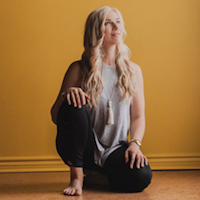A drop-in rate for yoga teachers or aspiring yoga teachers would facilitate networking, education, and true community support in your local community.
There’s a yoga teacher I know who was damn talented at teaching fluid, inspiring, and challenging vinyasa classes. He was a darling at the studio where I earned my teacher certification, earning the best time slots and packed classes.
Yogically, we both grew up in a university-town yoga community and when he moved away his teaching career effectively vanished.
Both of us completed certification through the studio that knew us well as devoted students and energy exchangers, thus were inclined to take us on when we were ready to teach. As my teaching practice grew, it wasn’t hard to teach for other studios as the community was small and reputations were swift to develop.
After leaving, I experienced many significant and frustrating barriers to getting into a studio. Moving several times and pursuing teaching with each move intimately acquainted me with various studio policies and yoga community dynamics. I’ve only experienced one studio—a by donation studio in Kingston, Ontario—that makes it easy for teachers to access an audition and afford weekly classes without ongoing commitment.
A drop-in rate for yoga teachers or aspiring yoga teachers would facilitate networking, education, and true community support in your local community. “Karma yoga” should be extended to the yogis trying to make it their offering.
Approaching new studios usually garners this response: “Get to know our community, and then we’ll see what happens.” As an advanced practitioner with a modest income, this meant that I would purchase the reduced rate introductory month pass. I was there to experience the studio and get to know the community, but a month is never enough time, especially in larger yoga centers.
At the end of the month, I found it challenging to get studio owners to commit to a conversation. The usual application of CV’s and references wasn’t working, and I suggested to many that we do a complimentary audition class or they allow me to sub.
I also tried a more direct approach: I’m good at this, and you should try me out. Sometimes it worked, but not for newly minted teachers, who have earned some teaching experience through volunteer work, and remain unfamiliar with the cultural machinations of a yoga studio.
New teachers have just invested deeply in their education, and it’s unfair and unrealistic to expect that they’ll be able to afford multiple, auto-renew memberships to get into various studios. A drop-in teacher rate would reduce this barrier and allow them to circulate within the community, learn from experienced teachers outside their YTT, and find a space that resonates with them.
Once they’re settled and teaching, they should still attend other studios. We all should, but our own income may be the barrier. Studios, out of a concern for income or teacher exclusivity, may promote this isolated approach to studio loyalty, but this strays from the right action of karma. I’m often saddened and frustrated by people who suggest that the ahimsa at the heart of our yoga practice is their way of life, yet speak divisively, even cruelly, about other teachers and studios.
If we reduce the distance between us to foster community, we support one another and demonstrate that the yoga is bigger than the business. We’ll be better teachers and yogis.
If you’re a studio owner, I encourage you to adopt a teacher drop-in rate.
If you’re a yoga teacher, discuss the concept with the studios and centers you teach at. Contextualize it and make it your own: maybe it’s only for teachers within the city, or teachers actively teaching or trying to teach.
If you run pre-registered classes, host a drop-in community night. Make their class pass $5 or $10, and send everyone an email to get the word around.
Start conversations with visiting teachers, and encourage your teachers to visit other studios.
Your community will thank you.
Love elephant and want to go steady?
Sign up for our (curated) daily and weekly newsletters!
Editorial Assistant: Kim Haas/Editor: Bryonie Wise
Photo credit: elephant journal archives



Read 9 comments and reply